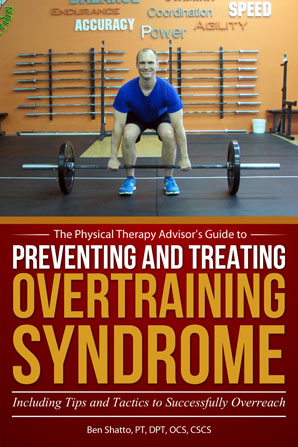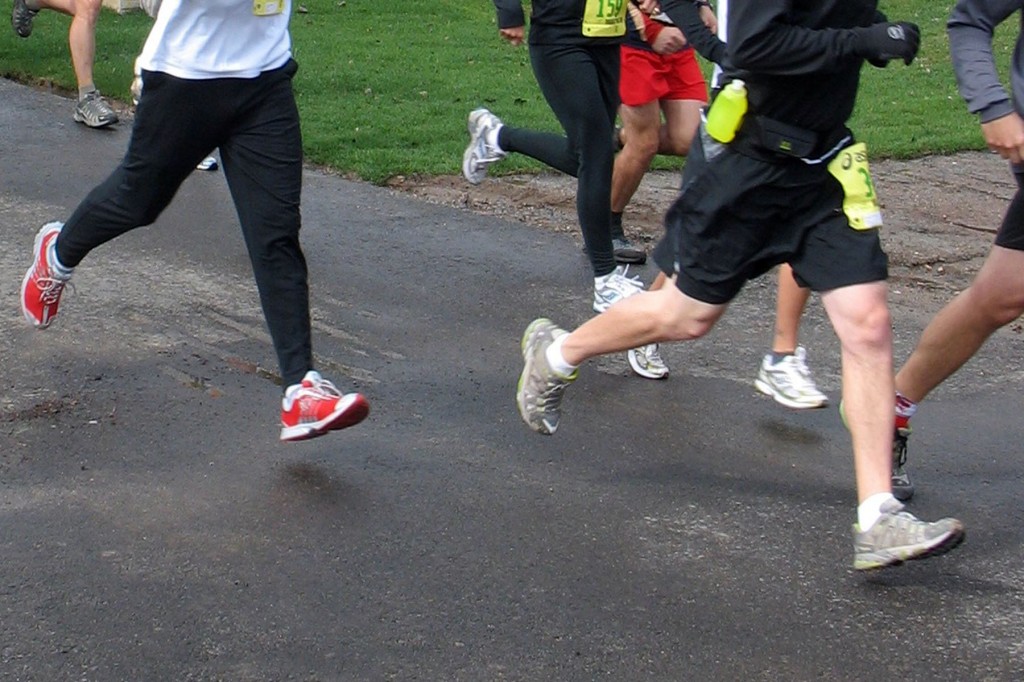If you exercise or participate in any sport, then you have likely had some experience with Overtraining Syndrome (OTS). It usually starts with extra muscle soreness and a feeling of fatigue. These symptoms can quickly morph into a serious case of overtraining syndrome. Overtraining can occur when the intensity and/or volume of exercise becomes too much for the body to properly recover from.
Although not well understood yet, research indicates two forms of OTS. One affects the sympathetic nervous system (SNS). The other primarily affects the parasympathetic nervous (PNS). Sympathetic OTS tends to affect sprint or power athletes. The resting heart rate tends to be elevated in the sympathetic form. Parasympathetic OTS tends to affect endurance athletes. In the parasympathetic form, the heart rate is even more decreased than typically found in endurance athletes.
There is no specific test for OTS. The diagnosis is usually determined when a number of factors or symptoms begin to manifest. Warning signs, ranging from mild to severe, include:
- Fatigue (mild to severe)
- Muscle and body achiness and soreness
- A sudden drop in performance
- A drop in strength
- A drop in cardiovascular endurance
- Insomnia or excessive sleepiness
- Headache
- Illness due to a drop in your immune function
- Irritability and moodiness
- Decreased appetite or weight loss
- An increase in your resting heart rate
- A decrease in your heart rate variability
- A substantial drop in training capacity and/or intensity
- Depression and a loss of enthusiasm for activities (such as training)
Avoid Overtraining Syndrome if you want to effectively train at a high level. It not only impedes your immediate performance, but it also substantially increases your risk of injury. Remember, recovery from a workout is a critical part in avoiding OTS. Your recovery routine should be an intentional and a multifaceted approach.
12 Tips to Prevent Overtraining Syndrome:
- Keep a training diary. An exercise or training diary allows you to keep track of how you feel before, during, and after workouts. How did your body respond to training that day? How did you sleep? How was your food intake and nutrition? Also, record your heart rate response during your exercise session. Document as many variables as you can in order to look for patterns. Discover which combinations work well for you and those that have a negative effect on training. Focus on the positive and eliminate variables which cause negative effects. The diary helps you to keep track of it all. There are software programs available to assist in this as well. One such program popular with cyclists and triathletes is Training Peaks.
- Monitor heart rate variability. Another potential warning factor for overtraining syndrome is heart rate variability (HRV). It is simply the variation in the time interval between heartbeats. HRV is affected by stress, hormone changes, and changes in the sympathetic or parasympathetic system. A decrease in parasympathetic activity or increased sympathetic activity will result in reduced HRV. A reduced HRV is a sign of OTS. The higher the HRV, the more capable your nervous system is able to adapt to stress. Many different apps can quickly measure HRV. Some apps are more accurate than others. The more accurate and precise the measurement, the more expensive the app. One free app that I use and recommend is Azumio’s Instant Heart Rate.
- Monitor for OTS warning signs. Watch for the warning signs (listed above) and decrease your training volume if you are experiencing symptoms. Listen to your body.
- Cool down. After performing your exercises, take the extra time to cool down and stretch. Choose exercises and activities that provide range of motion (ROM) to the particular area that you just trained or used. The perfect time to perform static stretching is after exercising. Work on tight and restricted areas. Keep moving throughout the day and avoid sitting for extended periods of time.
- Foam rolling. The foam roller is a wonderful tool which allows you to manipulate the body’s soft tissues. This has a potential positive effect on the fascial system, the musculotendinous system, and the circulatory system. It can aid in recovery by improving blood flow and reducing myofascial restrictions. To learn how to use a foam roller for self-treatment, please refer to Foam Rolling for Rehabilitation.
- Active recovery. Every day shouldn’t be an intense training day. As part of your training cycles, be sure to include time to participate in other activities to help the body to recover and rejuvenate. Participate in a yoga class, take a leisurely bike ride, or take a walk in the park.
- Proper periodization. You cannot and should not train at a super high intensity all year long. Your work volume needs to be properly periodized. Well-balanced gradual increases in training are recommended. Be sure your training plan varies the training load in cycles with built in mandatory rest phases throughout the year. The plan will likely be based on when you need to peak for certain events or races. During the high workload phase, try to alternate between high intensity interval work and low intensity endurance work.
- Taper up the training volume appropriately. The 10 Percent Rule is a guideline that many fitness experts use to help athletes (of all levels) avoid injury while improving performance. Many cases of OTS can be attributed to increasing the intensity, time or type of activity too quickly. The 10 Percent Rule sets a weekly limit on training increases. The guideline indicates not to increase your activity more than 10 percent per week. That includes distance, intensity, amount of weight lifted, and/or time of exercise. For example, if you are running 30 miles per week and want to increase the distance, add 3 miles during the next week for a total of 33 miles a week. If you are squatting 200 pounds and want to increase, don’t add more than 20 pounds during the next week. The 10 Percent Rule is only a guideline. In some cases, 10 percent may be too much. Instead, a 5 percent increase per week may be much more realistic.
- Rest more. Your body must rest in order to grow and develop. Training every day is not the best way to improve. It can lead to injury and burn out. Take a rest day and have fun. Sleep more. Proper programming includes mini cycles with an off season as well as active rest cycles in between heavy load and heavy volume training cycles. Don’t fear rest, embrace it!
- Eat healthy. Your body tissue needs nutrients to be able to perform at a high level. Avoid processed food as much as possible. Limit sugary food and add more protein and healthy fat in your diet. Maintaining a diet with adequate healthy fats is essential in providing the nutrients to support all hormone function in the body as well as support the brain and nervous system. Adequate protein intake is necessary to support muscle health and development. For more information on protein intake, please refer to How Much Protein Do I Really Need?
- Stay hydrated. The human body is primarily made of water, which is critical for all body functions. Adequate water intake is critical to avoid dehydration which can negatively affect your training. Dehydrated tissues are prone to injury as they struggle to gain needed nutrients to heal and repair. Dehydrated tissues are less flexible and tend to accumulate waste products. Stay hydrated by drinking water. Try to avoid beverages that contain artificial sweeteners or chemicals with names you can’t spell or pronounce.
- Supplement. I take certain supplements during times of heavy training volume or when I am in a phase of overreaching. I also take them intermittently to help prevent injury or heal from one. My most recommended supplement is CapraFlex by Mt. Capra. Essentially, it combines an organic glucosamine and chondroitin supplement with other natural herbs which are designed to reduce inflammation. CapraFlex can be taken long term or intermittently to help heal from an injury. I also recommend a colostrum supplement called CapraColostrum by Mt. Capra. Colostrum is the first milk produced by female mammals after giving birth. It contains a host of immunoglobulins, anti-microbial peptides, and other growth factors. It is especially good at strengthening the intestinal lining which prevents and heals conditions associated with a leaky gut. Colostrum can also help a person more effectively exercise in hotter conditions. Over all, it can boost the immune system, assist with intestinal issues, and help the body to recover faster. Both of these supplements can be used in heavy volume or intense training phases to help you to recover faster and avoid OTS. (If you are taking blood thinners, please consult with your physician prior to use as the herbs could interact with some medications.)
If you begin to experience any of the warning signs of OTS, be proactive about modifying your training. It is important to objectively measure your training routine and make adjustments before you become sick, overtrained or injured. Incorporate these recommended prevention strategies to help keep your training at a high level. In the follow up post, 10 Tips to Self-Treat Overtraining Syndrome, I specifically address self-treatment strategies.
If you are experiencing chronic aches or pain or are struggling with an aspect of your training, seek help immediately. Seeking advice specifically from an experienced coach, physical therapist, or physician can be beneficial.
Nothing can derail your best laid training plans and goals like an injury or suffering from OTS! If you develop OTS, you will need to take specific steps to speed up your recovery in order to prevent injury and return to a normal training schedule.

AVAILABLE NOW ON AMAZON!
In my book, Preventing and Treating Overtraining Syndrome, I show you how to recognize the risk factors and symptoms of OTS. You’ll learn how to utilize prevention strategies to help you develop a personal training strategy that will allow you to push past your limits and prior plateau points in order to reach a state of what is known as overreaching (your body’s ability to “supercompensate”). This will speed up your results, so that you can train harder and more effectively than ever before! In addition, learn how to use the foam roller (complete with photos and detailed exercise descriptions) as part of a health optimization program, recovery program, rest day or treatment modality.
Discover how you can continue to train hard and avoid the associated poor performance, illness, and injury that can result in lost training days and opportunity!

